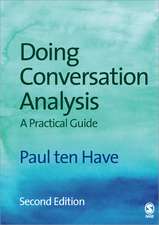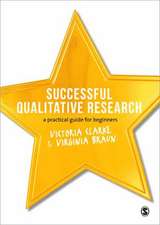Engaging Crystallization in Qualitative Research: An Introduction
Autor Laura L. Ellingsonen Limba Engleză Paperback – 17 sep 2008
While other books have explained how to write the "new ethnography" and autoethnography, and still others have described how to conduct grounded theory in more traditional, social constructionist, and postmodern, frameworks, this is the first work to date that has bridged these worlds in a "how to" book that celebrates each on its own terms, acknowledges inherent limitations of any genre, and explains how to integrate them through crystallization.
| Toate formatele și edițiile | Preț | Express |
|---|---|---|
| Paperback (1) | 552.20 lei 6-8 săpt. | |
| SAGE Publications – 17 sep 2008 | 552.20 lei 6-8 săpt. | |
| Hardback (1) | 841.89 lei 6-8 săpt. | |
| SAGE Publications – 18 aug 2008 | 841.89 lei 6-8 săpt. |
Preț: 552.20 lei
Preț vechi: 649.64 lei
-15% Nou
Puncte Express: 828
Preț estimativ în valută:
105.66€ • 109.01$ • 88.18£
105.66€ • 109.01$ • 88.18£
Carte tipărită la comandă
Livrare economică 27 martie-10 aprilie
Preluare comenzi: 021 569.72.76
Specificații
ISBN-13: 9781412959070
ISBN-10: 1412959071
Pagini: 240
Dimensiuni: 152 x 229 x 17 mm
Greutate: 0.32 kg
Ediția:1
Editura: SAGE Publications
Colecția Sage Publications, Inc
Locul publicării:Thousand Oaks, United States
ISBN-10: 1412959071
Pagini: 240
Dimensiuni: 152 x 229 x 17 mm
Greutate: 0.32 kg
Ediția:1
Editura: SAGE Publications
Colecția Sage Publications, Inc
Locul publicării:Thousand Oaks, United States
Recenzii
"[This] book emphasizes effective communication and how to articulate complex information to an audience. Although the book is intended primarily for qualitative researchers, I believe it may be an equally important work for quantitative researchers. In reading this book, I have gained a deeper appreciation for qualitative research in general and a better understanding of how different methods can be applied toward understanding truth."
"The book's key strength is its informed style and uplifting optimism about the future not only of qualitative research but of research at large...the book offers many ideas for researchers to play with and is a thorough and illuminating introduction to the theories, procedures, and politics of qualitative inquiry and publishing."
"The book's key strength is its informed style and uplifting optimism about the future not only of qualitative research but of research at large...the book offers many ideas for researchers to play with and is a thorough and illuminating introduction to the theories, procedures, and politics of qualitative inquiry and publishing."
Cuprins
1. Introduction to Crystallization
Constructing Crystallization
Considering Genres
Resisting Dichotomies: A Continuum of Qualitative Methods
Principles of Crystallization
Facets of the Crystal: Types of Crystallization
Strengths of Crystallization
Limitations of Crystallization
Ethnographic Exemplars
Organization of This Book
Conclusion: Frequently Asked Questions About Crystallization
Interlude: Introducing the Author
2. Ethics and Epistemology: Assumptions Underlying Crystallization
What Is Epistemology and Why Does It Matter in Crystallization?
Making Knowledge: An Epistemological Basis for Crystallization
Voicing Other and Self: Ethics of Representation
First Do No Harm: Some Ethical Cautions
Strategies for Ethical Decision Making in Crystallization
Conclusion
Interlude: The Limits of Genre--An Exercise About Ethics and the Construction of Claims
3. Illuminating Options for Analysis and Representation Across the Continuum
Traditional Forms of Analysis
Same Old, Same Old: The Value of Traditional Qualitative Writing
Aesthetics and Analysis: Hybrids of Art and Science
Aesthetic Possibilities: Creative Analytic Practices
Conclusion
Interlude: Resisting Dichotomy, Embracing Continuum
4. Strategies for Design: Putting Crystallization Into Practice
Wondering
Weighing Your Options
Re/considering the Role of Theory
Decide on a Design
Conclusion
Interlude: Beware the Law of the Hammer
5. Bringing It All Together: Integrated Crystallization
Creating a Coherent Multigenre Text
Blending Genres and Blurring Boundaries: Woven Crystallization
Woven Crystallization Exemplars
Sharpening Edges and Separating Spaces: Patched Crystallization
Patched Crystallization Exemplars
Issues in Constructing Integrated Crystallization
Interlude: Quilting as Activism
6. All Apart: Dendritic Crystallization
Dendritic Practices
Benefits of Dendritic Crystallization
Dispersing Crystallized Findings
A Dendritic Exemplar
But Is This Really Crystallization?
Interlude: Coincidence, Synchronicity, and Putting It Out to the Universe
7. Writing Across the Continuum
Evaluating Writing and Representation
Improving your Process
Writing Well
Bag of Tricks
Conclusion
Interlude: Representing Difference
Writing Resources
8. Publishing and Promoting Crystallization
Lessons of Crystallization
Call to Action: Employing Crystallization to Promote Social Justice
Getting the World Out: Pursuing Publication
Justifying Your Work
Enclosing Wild Power: A Conclusion/Invitation
Interlude: When Your Work Is Rejected
Constructing Crystallization
Considering Genres
Resisting Dichotomies: A Continuum of Qualitative Methods
Principles of Crystallization
Facets of the Crystal: Types of Crystallization
Strengths of Crystallization
Limitations of Crystallization
Ethnographic Exemplars
Organization of This Book
Conclusion: Frequently Asked Questions About Crystallization
Interlude: Introducing the Author
2. Ethics and Epistemology: Assumptions Underlying Crystallization
What Is Epistemology and Why Does It Matter in Crystallization?
Making Knowledge: An Epistemological Basis for Crystallization
Voicing Other and Self: Ethics of Representation
First Do No Harm: Some Ethical Cautions
Strategies for Ethical Decision Making in Crystallization
Conclusion
Interlude: The Limits of Genre--An Exercise About Ethics and the Construction of Claims
3. Illuminating Options for Analysis and Representation Across the Continuum
Traditional Forms of Analysis
Same Old, Same Old: The Value of Traditional Qualitative Writing
Aesthetics and Analysis: Hybrids of Art and Science
Aesthetic Possibilities: Creative Analytic Practices
Conclusion
Interlude: Resisting Dichotomy, Embracing Continuum
4. Strategies for Design: Putting Crystallization Into Practice
Wondering
Weighing Your Options
Re/considering the Role of Theory
Decide on a Design
Conclusion
Interlude: Beware the Law of the Hammer
5. Bringing It All Together: Integrated Crystallization
Creating a Coherent Multigenre Text
Blending Genres and Blurring Boundaries: Woven Crystallization
Woven Crystallization Exemplars
Sharpening Edges and Separating Spaces: Patched Crystallization
Patched Crystallization Exemplars
Issues in Constructing Integrated Crystallization
Interlude: Quilting as Activism
6. All Apart: Dendritic Crystallization
Dendritic Practices
Benefits of Dendritic Crystallization
Dispersing Crystallized Findings
A Dendritic Exemplar
But Is This Really Crystallization?
Interlude: Coincidence, Synchronicity, and Putting It Out to the Universe
7. Writing Across the Continuum
Evaluating Writing and Representation
Improving your Process
Writing Well
Bag of Tricks
Conclusion
Interlude: Representing Difference
Writing Resources
8. Publishing and Promoting Crystallization
Lessons of Crystallization
Call to Action: Employing Crystallization to Promote Social Justice
Getting the World Out: Pursuing Publication
Justifying Your Work
Enclosing Wild Power: A Conclusion/Invitation
Interlude: When Your Work Is Rejected
Notă biografică
Descriere
Extending upon the work presented in her first multi-award-winning book, Communicating in the Clinic, in this book Ellingson teaches others how to use crystallization, providing practical guidance for researchers' and students' implementation, thereby de-mystifying the process.









